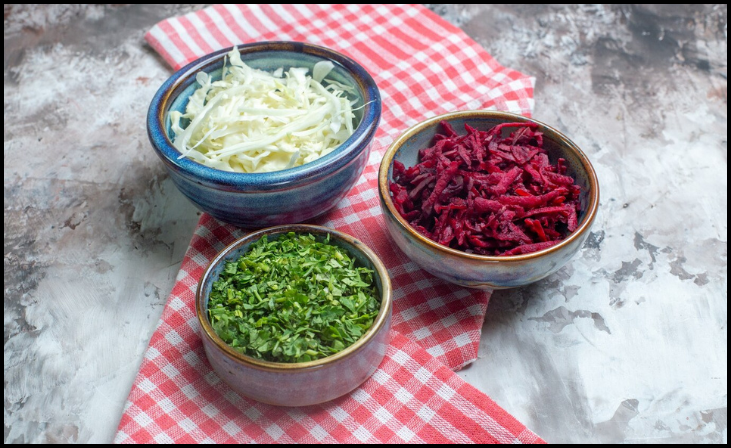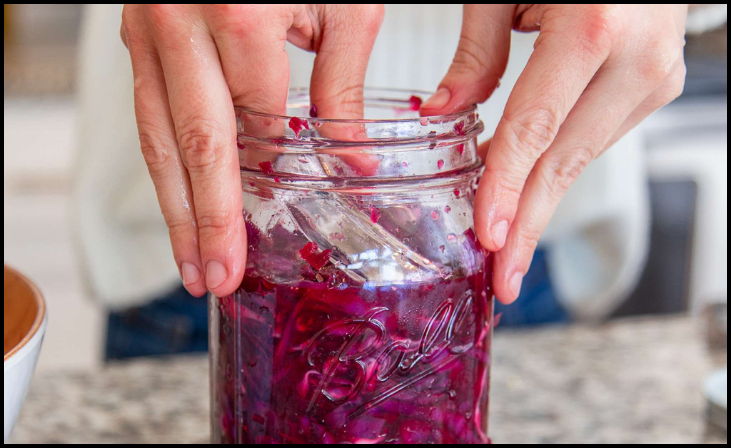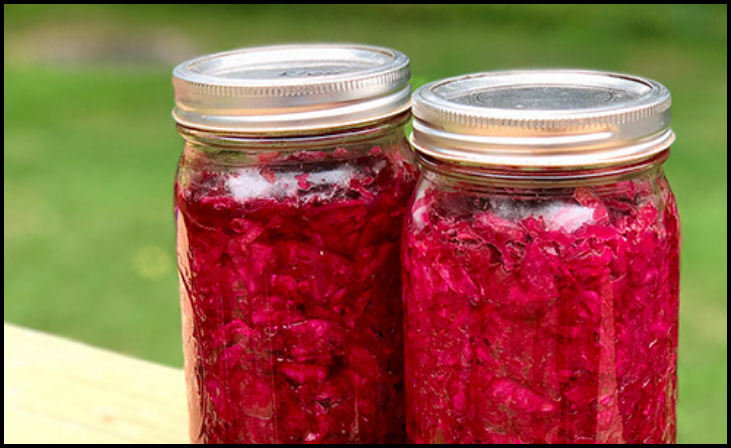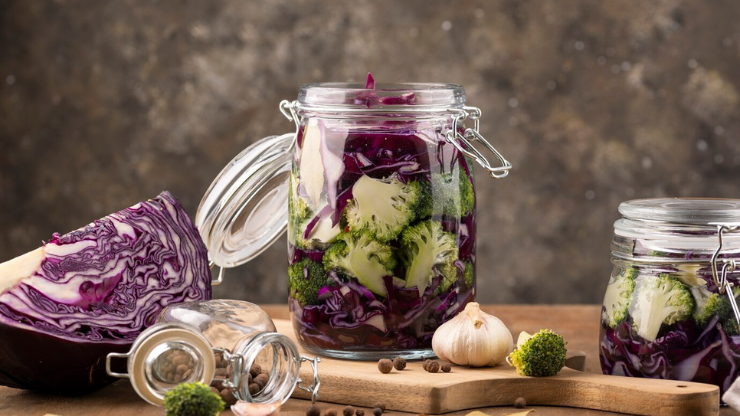Sauerkraut, a classic condiment known for its tangy and sour flavor, has a long history of gracing the tables of many cultures. While traditional sauerkraut is primarily made from cabbage, we’re here to introduce you to an exciting twist – Beet and Cabbage Sauerkraut. This colorful variation not only adds a vibrant hue to your dishes but also infuses your sauerkraut with a unique earthy sweetness.
In this blog, we’ll take you through the process of crafting your very own Beet and Cabbage Sauerkraut right in a jar. Whether you’re a sauerkraut aficionado or a curious culinary explorer, this recipe promises a delightful journey into the world of homemade fermented goodness.
Table of Contents
ToggleThe Art of Fermentation
Fermentation is a time-honored method of preserving foods while enhancing their flavors. In the case of sauerkraut, the natural sugars in cabbage are converted into lactic acid by beneficial bacteria. This transformation not only preserves the cabbage but also imparts a distinctive tanginess that’s loved around the globe.
By adding beets to the mix, we introduce a whole new dimension of flavor, texture, and color to our sauerkraut. The result is a bold and beautiful condiment that’s as visually appealing as it is delicious.
Ingredients You’ll Need
Before we dive into the preparation, let’s gather the ingredients for this delightful Beet and Cabbage Sauerkraut:
- 1 medium head of green cabbage
- 2 medium-sized beets (you can use red or golden beets)
- 2 tablespoons of sea salt (non-iodized)
- 1 tablespoon of caraway seeds (optional, for a unique flavor)
- Clean, sterilized quart-sized glass jar
Creating Beet and Cabbage Sauerkraut
Now, let’s walk through the steps of crafting this vibrant and tangy sauerkraut:
1. Prepare the Cabbage and Beets

To prepare the cabbage and beets for your Beet and Cabbage Sauerkraut, begin by washing them thoroughly to remove any dirt or impurities. Once cleaned, remove the tough outer leaves of the cabbage and set them aside. Using a sharp knife or a food processor, shred the remaining cabbage and beets into thin, uniform strips. This step ensures even fermentation and a pleasing texture in your sauerkraut.
The combination of cabbage’s crispness and beets’ earthy sweetness will add both flavor and color to your sauerkraut, making it a delightful addition to various dishes. This initial preparation sets the stage for the fermentation process that will transform these simple ingredients into a tangy and vibrant condiment.
For More- A Szechuan-Inspired Mala Pickle Recipe
2. Combine the Ingredients
Once the cabbage and beets are shredded, it’s time to combine the ingredients for your Beet and Cabbage Sauerkraut. In a large mixing bowl, place the shredded cabbage and beets. Sprinkle the sea salt evenly over the vegetables, and if you desire a unique flavor, add the caraway seeds.
The sea salt plays a pivotal role by drawing out moisture from the cabbage and beets, creating the brine necessary for the fermentation process. As you mix them together, you’ll start the journey towards crafting a flavorful and colorful sauerkraut, where the earthy sweetness of beets marries perfectly with the cabbage’s natural tang, resulting in a unique and mouthwatering blend of flavors.
3. Massage and Squeeze
The next step in crafting your delicious Beet and Cabbage Sauerkraut is to massage and squeeze the shredded cabbage and beets. This hands-on process is vital for breaking down the cell walls of the vegetables and encouraging the release of their natural juices.
As you massage the mixture, you’ll notice the cabbage and beets gradually softening and liquid starting to accumulate in the bowl. This liquid, combined with the sea salt, is crucial for creating the brine that will facilitate the fermentation process. Spending 5-10 minutes massaging and squeezing the cabbage and beets ensures that the brine forms, kickstarting the transformative journey towards a tangy and vibrant sauerkraut.
4. Pack It Tightly

After massaging and squeezing the cabbage and beets, the next step is to pack them tightly into a clean, sterilized quart-sized glass jar. It’s crucial to press the mixture down firmly to eliminate any air pockets and ensure that the vegetables are fully submerged in the brine. This step guarantees that the fermentation process occurs efficiently and uniformly.
As you pack the mixture into the jar, the liquid released during the massaging process should cover the vegetables entirely. This liquid, enriched with the flavors of the cabbage and beets, sets the stage for the sauerkraut to develop its unique tangy taste and beautiful color during fermentation.
Don't just scroll, subscribe!
BuzzTrail's unique web-stories are the cure for boredom you've been waiting for.
5. Use the Reserved Cabbage Leaves
The reserved tough outer leaves of the cabbage come into play at this stage of crafting your Beet and Cabbage Sauerkraut. Place one or two of these cabbage leaves on top of the tightly packed mixture in the glass jar. These leaves act as a natural barrier, ensuring that the shredded cabbage and beets remain submerged beneath the brine.
This is a crucial step because the vegetables must be fully covered by the brine to create the ideal environment for fermentation and to prevent mold or spoilage. The cabbage leaves serve as a protective layer, preserving the integrity of your sauerkraut and allowing it to develop its unique flavors and vibrant hues during the fermentation process.
6. Weight It Down
To ensure that your Beet and Cabbage Sauerkraut remains submerged in the brine during the fermentation process, it’s essential to use a weight. A clean, small glass jar filled with water or a purpose-made fermentation weight both work effectively. Place the weight on top of the cabbage leaves you previously positioned on the sauerkraut. The weight will exert gentle pressure, ensuring that the shredded cabbage and beets stay beneath the surface of the brine.
This step is crucial in preventing exposure to air, which can lead to spoilage. The weight not only safeguards the sauerkraut but also helps create a favorable environment for the beneficial bacteria to work their magic, transforming your mixture into a tangy and colorful delight.
7. Seal the Jar

After packing your Beet and Cabbage Sauerkraut into the glass jar and securing it with a weight, the next step is to seal the jar. You can use either a fermentation airlock lid or a regular lid, but ensure that it’s only loosely tightened. This is vital because during the fermentation process, carbon dioxide will be produced, creating pressure within the jar.
By leaving the lid slightly loose, you allow this gas to escape without compromising the seal’s integrity, preventing the jar from breaking. Alternatively, you can choose to “burp” the jar daily by briefly loosening the lid to release any built-up gas. Proper sealing is essential to protect your sauerkraut and ensure a successful fermentation process.
8. Ferment
The fermentation stage is where the magic happens as your Beet and Cabbage Sauerkraut transforms into a tangy delight. Store the sealed jar in a cool and dark spot, with an ideal temperature range between 60-70°F (15-21°C). Over the next few days, you’ll begin to notice small bubbles forming within the jar. These bubbles are a sign that the beneficial bacteria are at work, converting the natural sugars in the cabbage and beets into lactic acid.
This lactic acid not only acts as a natural preservative but also imparts the signature tangy flavor that sauerkraut is known for. The vibrant colors of the beets and cabbage will evolve as the sauerkraut ferments, creating a visually stunning condiment that’s as beautiful as it is delicious.
Fermentation time can vary according to your taste preference, so feel free to start sampling your sauerkraut after about a week, and when it reaches your desired level of tanginess, transfer it to the refrigerator to slow down the fermentation process and preserve the delightful flavors.
9. Taste and Adjust
As your Beet and Cabbage Sauerkraut ferments, it’s essential to periodically taste and adjust it to your liking. After about a week, begin sampling your sauerkraut to gauge its level of tanginess. The fermentation time can vary depending on personal preferences, so when it reaches the desired flavor profile, seal the jar tightly and move it to the refrigerator. The cold temperature will slow down the fermentation process, preserving your sauerkraut’s unique taste.
Whether you prefer a milder sauerkraut or one with an intense tang, this tasting and adjusting step allows you to customize your condiment to perfection. It’s your sauerkraut, and it should reflect your personal taste and culinary style.
Also Read- A Healthy Probiotic Mayonnaise Recipe
10. Store and Enjoy

Once your Beet and Cabbage Sauerkraut reaches your preferred level of tanginess, it’s time to store it and savor the fruits of your fermentation labor. Seal the jar tightly and place it in the refrigerator. The cold temperature will keep your sauerkraut fresh and preserve its unique flavors for weeks to come. This tangy and colorful condiment is a versatile addition to a variety of dishes, from sandwiches and hot dogs to salads and savory mains.
Enjoy the bold and earthy sweetness of the beets melded with the traditional tang of cabbage, and relish the fact that you’ve created a homemade delicacy that’s as visually appealing as it is delicious. Your Beet and Cabbage Sauerkraut is now ready to elevate your culinary creations with its vibrant taste and texture.
Conclusion
Beet and Cabbage Sauerkraut in a jar is more than just a condiment; it’s a testament to the art of fermentation. The synergy of flavors, colors, and the health benefits of probiotics make this homemade delight a must-try for any culinary enthusiast. Create your own jar, experiment with the flavors, and embark on a tangy, colorful journey that adds a delightful twist to your meals. Homemade sauerkraut has never looked, or tasted, this good.
FAQs
How long does the Beet and Cabbage Sauerkraut need to ferment?
How long does the Beet and Cabbage Sauerkraut need to ferment?
The fermentation time can vary depending on personal taste. Typically, after about a week, you can start tasting your sauerkraut to determine the level of tanginess you desire. Some prefer a shorter fermentation period, while others enjoy a longer one. It’s entirely up to you.
Can I use different types of beets for this recipe?
Can I use different types of beets for this recipe?
Absolutely! You can use red, golden, or any other beet varieties you prefer. Each type of beet will bring its unique flavor and color to the sauerkraut.
Is it necessary to add caraway seeds to the sauerkraut?
Is it necessary to add caraway seeds to the sauerkraut?
No, the caraway seeds are optional. They add a unique flavor to the sauerkraut, but you can skip them if you prefer a more traditional taste.
Can I use a plastic or metal container instead of a glass jar?
Can I use a plastic or metal container instead of a glass jar?
It’s best to use a glass jar because it doesn’t react with the acidic environment created during fermentation. Plastic and metal containers may affect the taste and safety of your sauerkraut.

